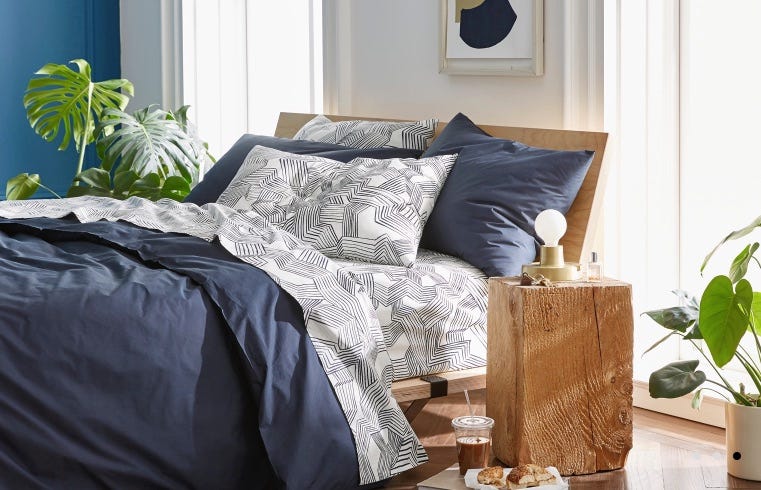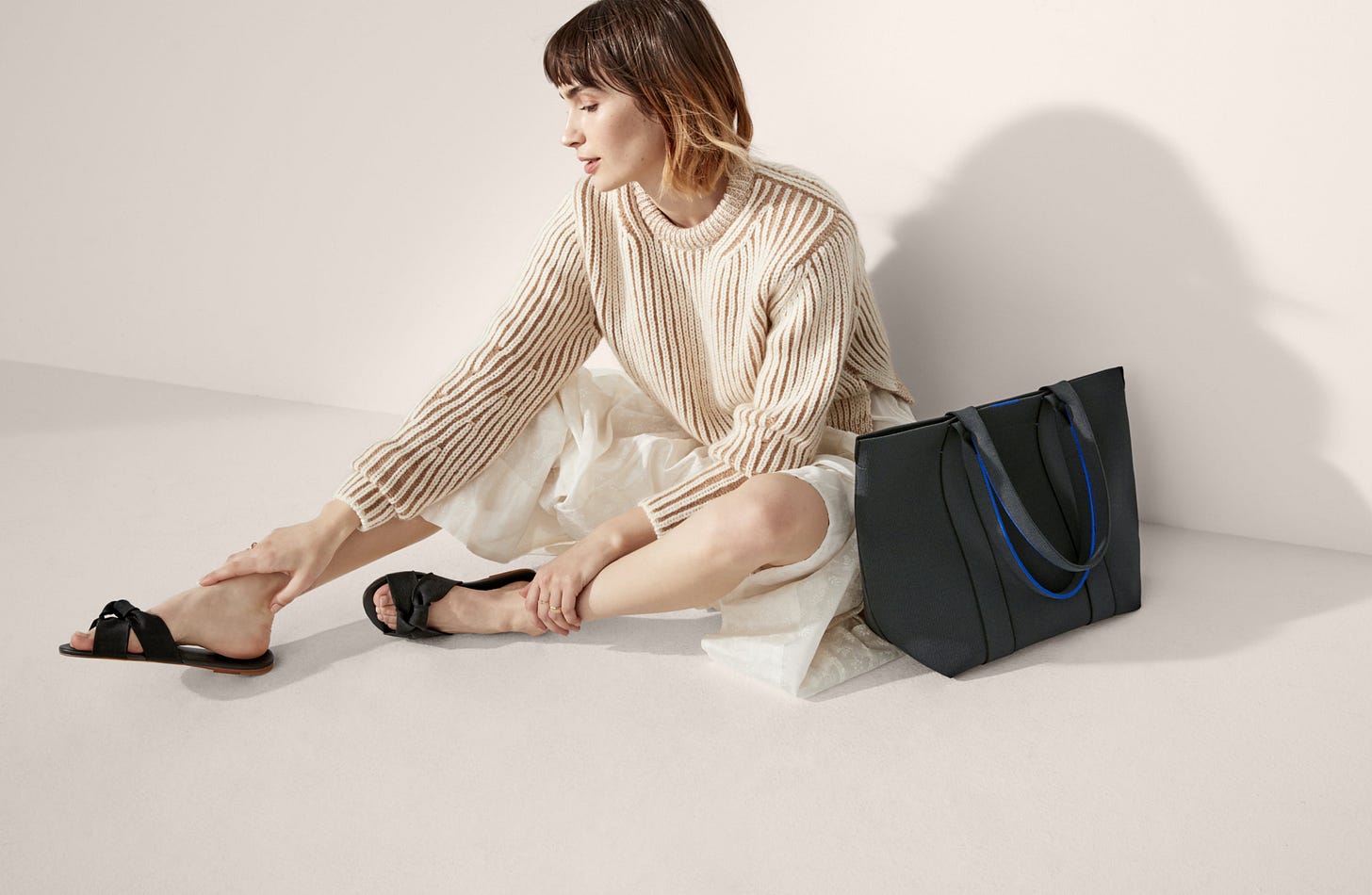👠 More brands should launch marketplaces
Why brand-curated niche marketplaces will be popping up everywhere
Hi Friends,
Thank you for tuning in for this week’s edition of Curious Commerce. I’m so happy to have you here! I’m Melina. I work as a strategist for retail and consumer businesses, and have my own womenswear brand, Keaton.
I did not publish last week because I felt at a loss about how to respond to the epidemic of police violence and brutality that has overwhelmed the country. I scrolled Twitter for hours trying to soak up information, but eventually that felt useless. My husband and I protested with our neighbors in Brooklyn and have been working on educating ourselves to be better allies. I have the tendency, likely driven by my privilege, of being quick to jump to discussing solutions. I’m not very good at sitting with discomfort and pain. I’m working on being a better listener and allowing others the space to feel.
Instead of writing any more about this myself, I’m going to amplify a few valuable resources from black authors and activists:
Some Resources
📚 Anti-Racist Resource Guide - I’ve purchased several books from this list. You can find a black-owned bookstore to buy from directly on Bookshop or from this list.
📚 Take Yale’s free online course- African-American History, From Emancipation to the Present
📈 Valuable data on police violence:

💸 Places to donate ($, resources, and time)
✨ 77 Black-owned businesses to support right now-a few of my personal faves:
Briogeo - the best natural products for curly hair (also at Sephora)
Rebecca Allen - nude shoes in a wide range of shades
BasBaas - I’m a hot sauce addict and these Somalian sauces are 🔥
Jungalow - thanks to the fun tropical aesthetic pioneered by this blog-turned-home decor site, there are ~100 plants in my tiny apartment right now.
More brands should launch marketplaces
It’s a low-investment move with a lot of potential to generate insights and diversify revenues
The majority (58%) of online sales happen via a B2C marketplace—a site that processes transactions from multiple brands for sale to consumers. Worldwide, they represent more than $2T in sales and grew 22% in 2019. Amazon, Walmart, and eBay are the three largest in the U.S., but there are many players that serve specific categories or market segments. Net-a-Porter and Farfetch aggregate luxury brands and provide white-glove delivery service and high-end editorial content. Shopbop and Revolve cater to fashion-minded young women. Etsy serves lovers of crafting and homemade items. Wayfair sells furniture and home goods. The list goes on.
How marketplaces work (simplified)
Marketplace lists products from multiple brands for sale.
Marketplace makes money in a few ways. On Etsy, it’s a mix of listing fees and commissions. On Amazon, there are myriad fee structures including listing fees, commissions, and subscriptions.
Marketplace gathers data on what customers search for and what is selling. The data becomes its own asset—they share it selectively with brands to build loyalty and improve site performance.
Marketplace leverages this data to develop private label products (and/or exclusive brands). These have higher margins for Marketplace, and can be priced to undercut branded products. (Amazon had at least 135 private label brands as of Spring 2019).
Marketplace can further monetize by providing additional services to brands, like pack-and-ship, storage facilities, the ability to promote listings, and more.
Brands are rethinking this model
I’ve written in the past about how one of the key benefits of DTC is the data gathering that happens from owning the entire customer relationship, from discovery through purchase. Armed with an understanding of what customers want and direct ways to reach them, brands have started creating their own marketplaces.
Brooklinen launched Spaces in 2019, offering curated home goods outside their core offering of bedding. According to founders Vicki and Rich Fulop (via the How I Built This podcast), the Brooklinen team was already doing the work of curating and styling other home goods products in creative materials (like this pretty bedroom below). Customers would reach out to ask where items in the photos were from, and Brooklinen saw the opportunity to formalize this transaction, and make some money in the process. Thus, Spaces was born.

Why launching a marketplace makes sense
Building out a marketplace is a smart move for any brand that is already driving significant organic traffic to its site. Brands with robust communities and content strategies are best-positioned to make this move.
Extend CLV
One challenge of being a DTC brand is that your assortment is typically pretty limited. As a brand, you’ve already paid to acquire a customer and bring them to your site. Providing them with additional relevant purchase options extends CLV. If the marketplace is robust, the customer will return more often and will be more likely to repeat purchase in your core categories as well.
Diversify revenues
Offering additional product categories via a marketplace serves to de-risk the core business. As the result of COVID, entire categories shrank by 50%+ in the span of just a few weeks (cough, women’s workwear). While this is an extreme case, branching beyond your core assortment can provide a much-needed source of outside revenue when times are challenging.
Drive more traffic
The cardinal goal of any eCommerce site is to increase the number of eyeballs visiting it. Creating shoppable content that is relevant to your visitors’ needs will give another reason to visit and share.
Gather insights
You may be asking, “if diversification is so great, why don’t brands just launch additional categories?” By starting with a curated selection of third-party brands, the marketplace owner can observe consumer behavior in these categories before making the costly decision to launch a new product. They can see exactly what is selling well in adjacent categories, which price points resonate best, and what features customers value. These insights are informed by actual purchase data, which is more valuable than surveying customers. Similar to the private label approach employed by traditional marketplaces, brands can use their marketplace to inform strategic decisions.
Build a reputation as a “curator” in your category
Continuously producing relevant, unique, and valuable content for your audience is a challenge for any brand. Listing additional products provides a well of content and curation opportunities. Visitors to a brand are likely seeking information about how to use that product as part of their daily lives. A thoughtfully-designed marketplace provides inspiration for this. Ana Andjelic describes the value of curation:
Knowing where to go and what to do is the currency that, in the modern aspiration economy, makes curators more important than influencers. They guide their audience through culture by putting forward a selection of images, references, codes, product releases, or memes. Curation gives even mundane objects value by connecting them with a point of view, heritage, a subculture or purpose that makes them stand out in the vortex of speed, superficiality, and newness.
By selling products from other brands, the lead brand has the opportunity to borrow some of the “cool factor” from smaller, up-and-coming brands. They position themselves as an authority in their broader category.
A few words of caution
I’m excited about the marketplace business model for brands, but it must be approached with caution. Brooklinen’s Spaces concepts works because it is highly-tailored. They sell products that are directly related to the home (furniture, plants, decor). If they branched into recommending electronics, the venture would feel like an indiscriminate cash-grab rather than a resource for customers.
The key focus when building a marketplace should be on delivering value to customers first, and making money second.
Also, brands face some reputational risk from listing other brands on their site. We saw just this weekend how Reformation, known for its sustainability credentials, has faced criticism for racist practices. Brands must stay on top of the labels they partner with to ensure that they aren’t tacitly endorsing problematic behavior.
Why participating in a marketplace makes sense
The other side of the marketplace is the third-party brands that must be willing to take part. The best candidates for niche marketplaces are small, up-and-coming DTC brands.
Over the past 5 years, it has become 50% more expensive on average to acquire a customer. Brands are hungry for new ways to reach customers, and participating in a niche marketplace is a reasonable option. While they may need to part with a few percentile points of each sale, this cost is likely similar or less than other acquisition channels.
Additionally, participants in these marketplaces are reaching qualified, relevant potential customers. Furniture brand Inside Weather sells on Brooklinen’s Spaces. They are reaching customers who likely fit their target demo very well—Millennials who are investing in upgraded linens and seeking chic and reasonably-priced home decor. Reaching the right audience with your brand—especially as a young company—is very valuable.
Some of these brands might struggle to stand out in a large marketplace like Amazon, where sales volume, number of reviews, and price are important ranking factors. Niche marketplaces are a valuable channel as a brand reaches the scale it needs to successfully play in larger channels.
Rothy’s should build a hub for sustainable fashion

Rothy’s, the sustainable footwear brand, boasts a super-loyal following including “super-fan” Facebook groups with thousands of members. These groups collect limited edition colorways, swap shoes, and discuss upcoming launches. This fandom stemmed from a relatively small assortment of shoes manufactured from plastic water bottles (the brand launched bags in March of this year).
I think Rothy’s, with its loyal audience and strong sustainability credentials, is well-positioned to curate a marketplace in an adjacent category, women’s clothing. In creative images, the shoes are styled with complete outfits, yet the brands worn are not listed on their site. In blog posts like this one, women share how they style their favorite Rothy’s shoes, but there are no links or information about the clothes. On Instagram, there are many comments asking about where clothing comes from, but Rothy’s doesn’t provide links.
Rothy’s should build a tab on their site called “Sustainable Wardrobe” that features a limited collection of sustainable apparel that can be styled with the shoes. They could showcase up-and-coming labels that share the same ethical values and mirror a similar price point. Brands like Amour Vert, Pact, and Bscly are good contenders for a venture like this. This provides an opportunity for Rothy’s to further deepen their relationship with customers, who are clearly seeking inspiration and guidance on head-to-toe sustainable dressing.
Closing thoughts
The ongoing decline of department stores is creating a void that curators can fill. Many used to browse the aisles of Nordstrom or Macy’s to discover cool new brands. With these stores currently closed in much of the U.S. and with their long-term prospects uncertain, brands can take on the role of curators with their own marketplaces.
Interesting nuggets from around the web
Amazon is the fourth-largest US delivery firm / how brands and agencies are defunding reporting on racial injustice / Vertical social networks are the next big thing / Clorox goes DTC/ Thingtesting adds a filter for black-owned businesses / Madison Reed’s founder on what’s next / What’s next for Peloton
*If you’ve published anything related to the future of commerce, I’d love to help amplify your work. Reply to this email with a link and I’ll try to include it in next week’s newsletter*
✨ Stay Curious,





